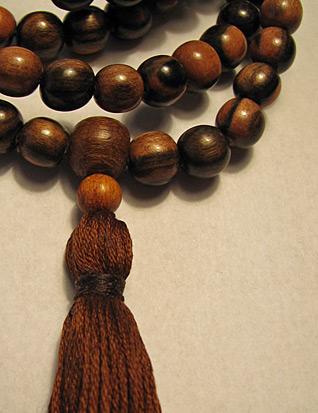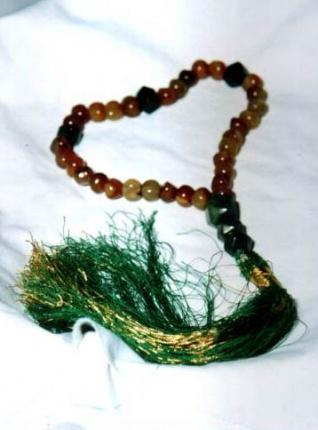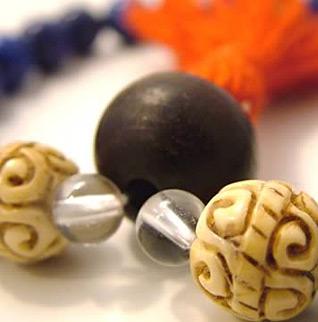
Below, third from bottom: The tassabi (mala, rosary) presented by Guru Arjan to Hazrat Mian Mir at the time of his laying the foundation stone of Harmandar Sahib. This tassabi is now with the family of Makhdoom Syed Chan Pir Qadri.



Faith
What is a Mala (Rosary)?
by JAGDEV SINGH KAINTH
People have a variety of opinions on the significance of the number of beads - 108 - used in many of the Jap-malas and rosaries, and on the very use of them in religious and spiritual practice.
Here are the facts, as I see them, behind this number and, of course, the mala:Malas are being used continuously in different shapes and sizes by the people of different religions and regions. They use different kind of beads for making a mala or rosary.
The purpose behind each mala and rosary is the same. It assists the devotee in reciting specific prayers in the name of God.
Christianity, Islam, Buddhism and Hinduism are the four major religions of the world that use beads in some form and in a definite number in all of their religious and ritualistic roles.
[Editor: Sikhism doesn't as a rule, though some Sikhs do use it as an aid to simran (meditative worship). It is not essential, but it can be used to advantage at least by the beginner, and by those who wish to get further into the discipline of simran. And, the number of beads, though significant in other faiths, is of no relevance in Sikhi.]
The English word "bead" is derived from the Anglo Saxon words "bidden" (to pray) and "bede" (prayer). So a small ball of glass was known as a bead during the earlier ages, and was used for counting prayers or for ornamentation.
The use of beads in prayers appear to have originated with early religious practices in India, possibly around the 8th century BCE by monks and sadhus who used to live in solitary confinement for the sake of their mental concentration.
Previously, monks would count their prayers by counting on their hands and fingers and this counting process was very tedious. Later on, they started counting their prayers by casting pebbles into a bowl or a similar utensil. This kind of counting was not possible out of their huts where they used to live.
Slowly, the idea of a thread came to the mind of the devotees. They started making knots all along the length of the thread and this counting process started. Soon the devotees realized that the length of the thread was not convenient to counting and the closed loop came into existence, where the thread was terminated into a big knot as the starting-point and the end-point.
With the gradual advancement of science and technology, the place of the knot was taken over by the beads and the colour also changed in accordance with the personal preference of the individual.
There is a saying that every stone has a story to tell. Similarly each stone in the mala also has a story to tell. The number of stones in a mala varies with the aspirations of the devotee. The number of stones are not the same for different kind of desires to be fulfilled.
For example, there are people who want only spiritual progress in their lives. Then there are others who want final moksha or liberation. There are many who want wealth in abundant quantities. Then there are others who pray for the acquisition of negative energies and, lastly, there are people who want the fulfillment of all their desires, or to have no desire at all.
Why is the Mala used?
It is one of the simplest methods of counting while chanting God's Name. It allows you to get into a rhythm and spend some serious time while praying.This method of counting is very conveniently used for the concentration of mind because our mind is like a wild horse, running helter-skelter without a fixed goal. It wanders all over the map when we pray.
So a mala in the form of a tactile object in the hand allows the devotee to focus and helps him to go deeper in terms of realisation.
The use of a mala in itself is not a way to worship. It is an aid to the devotee because his goal is to not live in the head any more.
The role of the mala is to allow the person to hold and move the beads in accordance with the rhythm of the prayer. One can chant, changing the tune, rhythm and rate of chanting, in order to make the prayer more fruitful and enjoyable.
Dr Jagdev Singh is a nuclear scientist, based in Calcutta, India.
[Courtesy: The Sikh Review]
September 25, 2008
Conversation about this article
1: Dass (Italy), September 26, 2008, 2:48 AM.
Very interesting. I use a mala for simran and agree with everything that you've written.
2: Charan Singh (Canada), September 27, 2008, 1:42 PM.
Hasn't the Guru recommended the mala (beads,rosary) of breath, using each breath as a bead to remember Waheguru and get connected? The mala of the breath is far more effective than the mala in the hand.
3: Gaurav Singh (Palatine, Illinois, U.S.A.), September 29, 2008, 4:31 PM.
"Mathe Tilak, hath Mala bana(n). Logan Ram khilauna jana(n).1. Jou hou boura tou Ram toura. Log maram keh janai mora. (Rahao)." [[With a mark on their forehead, a rosary in their hands, and by wearing "religious" attire, these (naive) people imagine God-realization to be a petty game, and God to be a child's toy. Says Kabir, I shall not engage in these false games, even though they (that practice these petty games) may call me a fool. Lord! They may see me as a fool, but I am Your fool. They do not know the secret and intensity of my love for (and connection with) You.]] Others confuse Simran with making a rosary of their breath - as in Pranayam, a calculated exercise. Lest I be misunderstood, in using the metaphor of a rosary of breaths as Simran, Guru Sahib does so to explain a much more gowerful meaning of Simran. Simran is Remembrance that is born of our actual connection and love for all that we hold dear. Simran is (as Bhagat Namdev explains) the same as when a young maiden balances a pitcher of water on her head on the way back home from the village well, all the while chatting with her friends - she will not let the pitcher fall. Simran is what is practiced by the goldsmith whose focus is on the fragile jewelry s/he is shaping, all the while entertaining customers. Mothers/fathers are in perpetual Simran of their child ("Did s/he just wake up?", "Is my child in distress?") while doing their daily chores. There is no calculation or breath control involved in any of these activities we practice everyday. The key is in the same Shabd by Bhagat Namdev (as the examples given above), when he says my Man (mind, soul) is pierced by Naam. He is referring to a life of Love-in-practice. An everyday example makes the meaning just as clear. Any one who has had a worldly crush can relate to the power of this sentiment. Is s/he not always on your mind, even though you may be at work or school, you could be eating or talking to a friend, etc.? You just cannot get her/him out of your mind! When this happens, you are in Simran. It is no different with Akal Purakh, who is never far, and Love for whom does not depend upon how many times we count a word (as though it were His name - He is Nameless). To be pierced by Naam is another matter altogether and best discussed separately from an article on a Mala.
4: Hardeep (Malaysia), October 14, 2008, 11:38 PM.
A sakhi to share. There was once a fakir who was walking along, searching for a place to meditate. He held a mala in his hand. As he moved along, looking for a suitable place, he came across a woman selling carrots at the side of a lake. The fakir observed her actions. Her carrots were said to be the freshest amongst the three villages that were around the lake and so she charged a high price for her carrots. She loudly counted the carrots as she selected them carefully for her customers and they paid her for them. Suddenly a man came to her and smiled at her. She started picking all the best and freshest of her carrots and gave them to him, while disregarding her regular counting. She did not even ask for payment. Seeing this, the fakir became curious and inquired who the man was. She replied, "My fiance". "But you just picked up all your best carrots and gave him and you did not even count how many you gave away", said the fakir "There is no counting with one's beloved, oh fakir," she replied. Listening to her remark, the fakir looked at his mala, and in one swift action threw it into the river. We are all playing the game of love here; simran is that game. So why bother counting. Don't count, my friend. Don't even think about how many minutes of simran you do or how many times you say Waheguru. You will only feed your ego if you do that. Instead, say Waheguru every opportunity you get!
5: Sat Pavan Singh (Pennsylvania, U.S.A.), August 28, 2011, 10:49 AM.
I understand both sides ... Now I feel the middle-path is the way I understand. We are embodied and, especially as beginners, feel the need to have a practical way to help focus the restless mind, not so much for counting. If a person can, then do go past beyond the "rope" into the ocean of nectar. But I am a novice, so I will still, for now, hold on! Waheguru ...
6: Ishwar Singh (Ludhiana, Punjab), June 10, 2012, 2:12 AM.
Thank you for the info, Sir.
7: Steven Jeske (St Louis, Misssouri, USA), March 03, 2014, 12:06 AM.
The perspective between Sikh, Hindu, Buddhist and Muslim is similar yet different. My basic concern was if a Sikh used prayer beads at all, and if so, how many beads. I have strung and repaired prayer beads for all faiths at this point, except Sikh believers. Just don't know any from around St Louis, Missouri. I am impressed by how Sikhism started because of a reaction to Muslim-Hindu animosity.


